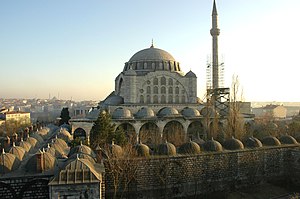Τέμενος Μιχριμάχ Σουλτάν (Εντιρνέ Καπού): Διαφορά μεταξύ των αναθεωρήσεων
μ WikiCleaner 0.98 - Repairing link to disambiguation page - You can help! |
μ pt.iw |
||
| Γραμμή 132: | Γραμμή 132: | ||
[[ca:Mesquita de Mihrimah]] |
[[ca:Mesquita de Mihrimah]] |
||
[[mk:Џамија Михримах Султан]] |
[[mk:Џамија Михримах Султан]] |
||
[[pt:Mesquita de Mihrimah Sultan (Edirnekapı)]] |
|||
[[tr:Mihrimah Sultan Camii (Edirnekapı)]] |
[[tr:Mihrimah Sultan Camii (Edirnekapı)]] |
||
Έκδοση από την 20:37, 15 Σεπτεμβρίου 2010
| Mihrimah Mosque | |
|---|---|
 Mihrimah Sultan Mosque, 2008 | |
| Βασικές πληροφορίες | |
| Τοποθεσία | Istanbul, Turkey |
| Γεωγραφικές συντεταγμένες | 41°01′45″N 28°56′09″E / 41.02917°N 28.93583°E |
| Υπαγωγή | Islam |
| Χώρα | Τουρκία |
| Αρχιτεκτονική περιγραφή | |
| Αρχιτέκτονας/Αρχιτέκτονες | Mimar Sinan |
| Αρχιτεκτονικός τύπος | mosque |
| Έναρξη ανέγερσης | 1562 |
| Αποπεράτωση | 1565 |
| Λεπτομέρειες | |
| Ύψος θόλου (εξωτερικό) | Πρότυπο:M to ft |
| Διάμετρος θόλου (εξωτερική) | Πρότυπο:M to ft |
| Μιναρές/Μιναρέδες | 1 |
| Υλικά | granite, marble |
The Mihrimah Sultan Mosque (τουρκικά: Mihrimah Sultan Camii) is an Ottoman mosque located just inside the Edirne Kapisi on the Byzantine land walls of Istanbul, Turkey. Located on the peak of the Sixth Hill near the highest point of the city, the mosque is a prominent landmark in Istanbul.[1]
History
The Mihrimah Sultan Mosque was designed by Mimar Sinan ("Sinan the Architect") for the favorite daughter of Suleiman the Magnificent, Princess Mihrimah. Its building took place from 1562 to 1565. [2] The complex has been severely damaged by earthquakes several times (including 1719, 1766, 1814 and 1894), and although efforts were made to restore the mosque, its attendant buildings received less attention. The dome was further damaged during 1999 İzmit earthquake, and required restoration, along with the upper half of the minaret.
Architecture
Exterior
The mosque was built on a terrace overlooking the main street. A large courtyard (avlu) whose interior portico is divided into individual cells forming a madrasah surrounds the mosque. In the center of the courtyard is a large ablution fountain (sadirvan). Entry to the mosque is through an imposing porch of seven domed bays with marble and granite columns. [3] The mosque itself is a cube topped by a half-sphere, with symmetrical multi-windowed tympana on each of the four sides. The dome is supported by four towers, one in each corner; its base is pierced by windows. The single minaret is tall and slender; during the 1894 earthquake it crashed through the roof of the mosque.
Interior
The interior is a cube under a dome 20 m in diameter and 37 m high. On the north and south sides, triple arcades supported by granite columns open onto side aisles with galleries above, each with three domed bays. A vast amount of surface area is covered by windows, making the mosque one of the brightest lit of any of Sinan's works. Some of the windows contain stained glass.
The interior stencil decorations are all modern. However, the mimbar in carved white marble is from the original construction.
Complex
As built, the Mihrimah Sultan Mosque had a kulliye which included (besides madrasah) a double hamman, turbe and a low row of shops under the terrace upon which the mosque was built, whose rents were intended to financially support the mosque complex.
The complex does not include the grave of Mihrimah Sultana herself (which is located at the Süleymaniye Mosque, but a ruined turbe (which is also a work of Sinan) behind the mosque houses the graves of her son-in-law, Grand Vizier Semiz Ali Pasha, as well as many other members of her family.
See also
Gallery
-
Dome.
Συντεταγμένες: 41°01′45″N 28°56′09″E / 41.02917°N 28.93583°E
References
- Faroqhi, Suraiyah (2005). Subjects of the Sultan: Culture and Daily Life in the Ottoman Empire. I B Tauris. ISBN 1850437602.
- Freely, John (2000). Blue Guide Istanbul. W. W. Norton & Company. ISBN 0393320146.
- Rogers, J.M. (2007). Sinan: Makers of Islamic Civilization. I B Tauris. ISBN 184511096X.
External links
- Photos of Mihrimah Sultan Mosque in Edirnekapi
- Mihrimah Sultan Mosque in Edirnekapi
- Mihrimah Sultan -- an Ottoman princess’ legacy survives

